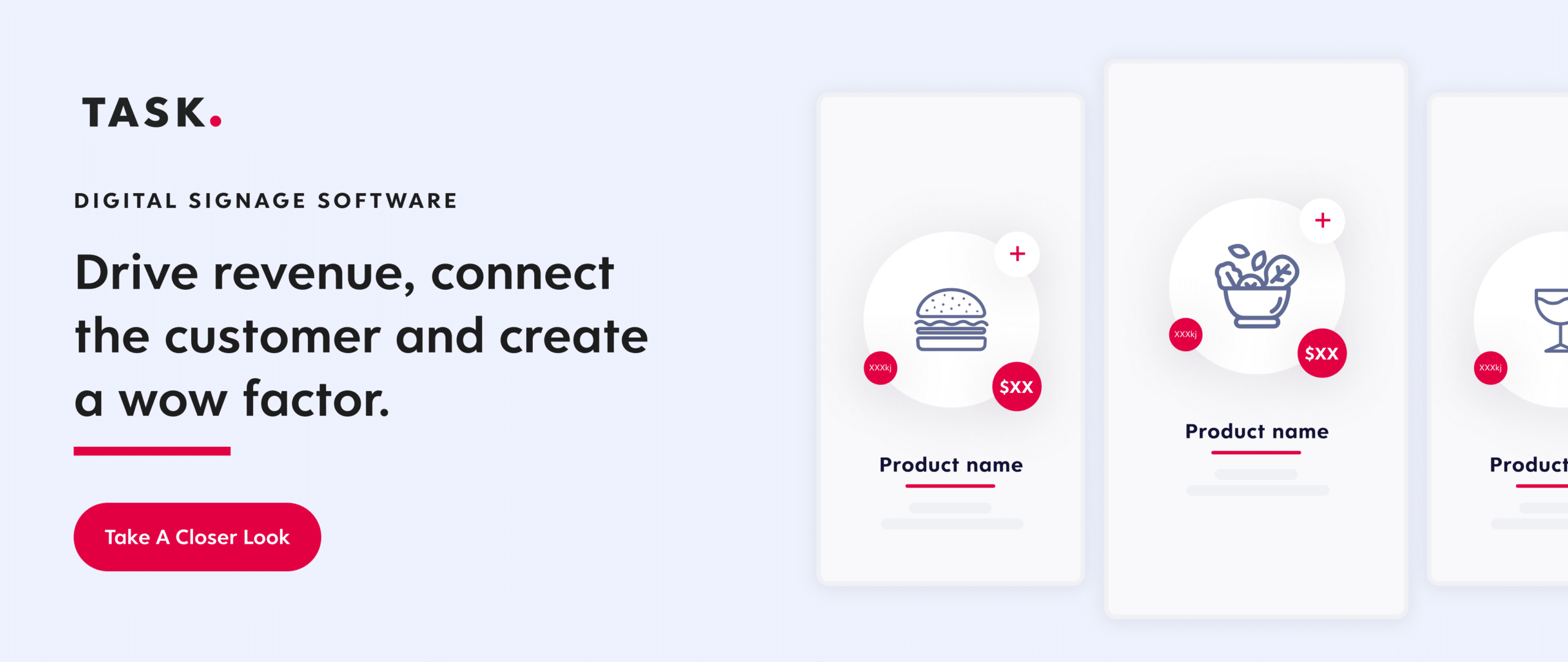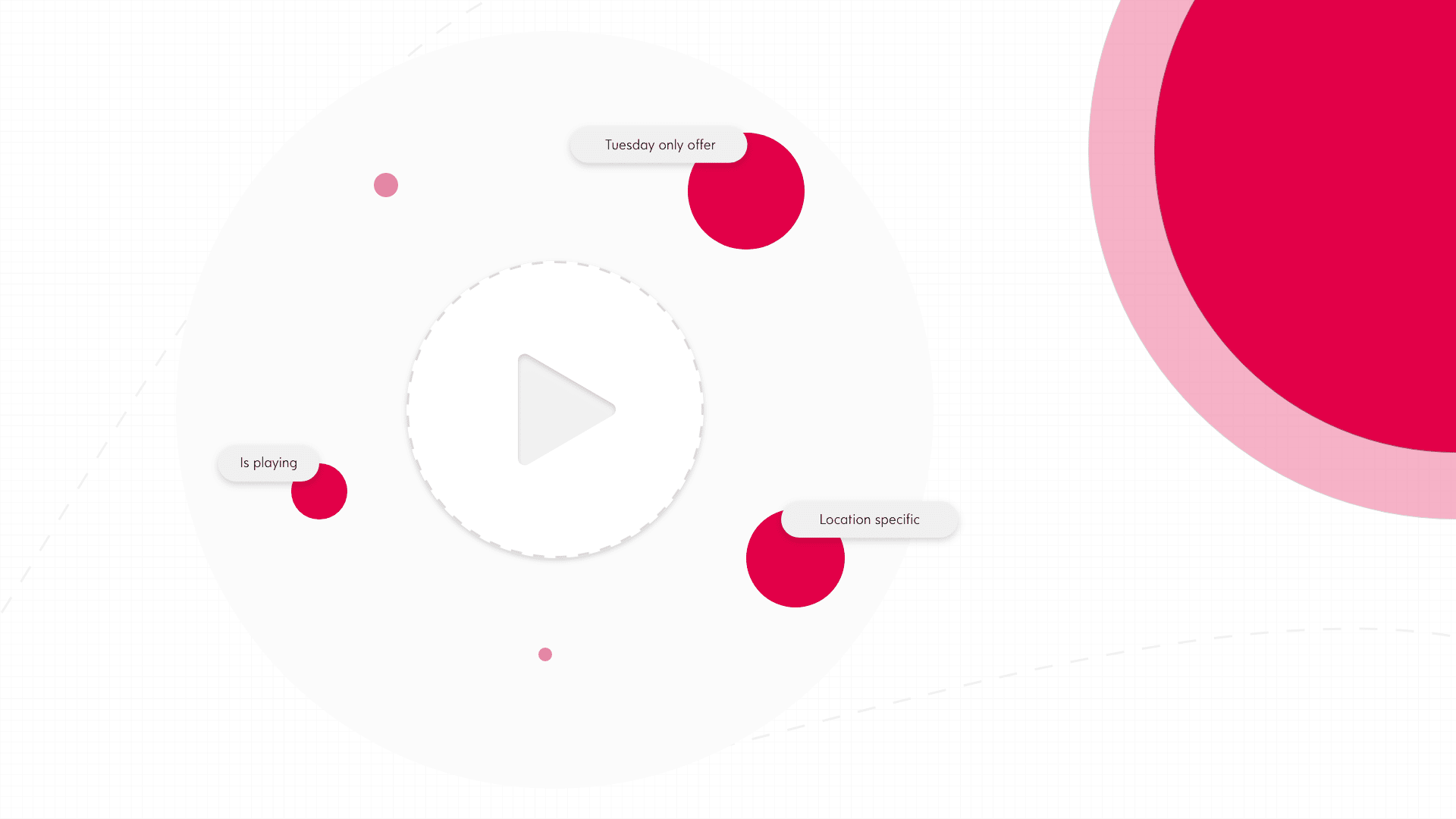Omnichannel marketing and branding are paving the future for hospitality businesses – driving consistent, engaging experiences for customers both digitally and in person.
While digital signage is not necessarily a new piece of technology for businesses, it is a highly underutilized tool when it comes to curating effective marketing communications. Between 30 and 40 percent of purchasing decisions are made in-store, right before ordering at the counter. What this means for restaurant businesses is that there is ample opportunity within storefronts or at the drive-thru window to influence customers’ ordering decisions.
Here’s how you can leverage the power of digital signage to support higher sales revenue and better customer engagement across all your touchpoints.
Why is a Digital Signage Content Strategy Important for Restaurants?
Restaurant businesses have historically invested heavily in visual displays and in-store signage to entice new purchasing decisions and share new offerings with their customers. However, when it comes to digital signage, less than half of restaurant businesses have a clear content strategy. These brands aren’t just lagging behind their competitors – they’re also missing out on huge marketing opportunities.
Digital signage goes far beyond the capabilities of a traditional display. With a mobilized strategy, digital signage makes it possible for businesses to:
- Communicate messages effectively with customers
- Drive brand authenticity and consistency
- Adapt over time to reflect current and relevant customer needs
- Seamlessly manage employees using real-time order screens and kitchen display systems
An effective digital signage marketing strategy combines the technological capacity of an adaptable screen with in-depth knowledge about changing customer needs based on transactional and consumer data.
With the ability to update and change in real-time, brands can curate messaging to fit changing details – such as the time of day, the current specials or offerings, location-specific needs and trends, and customer demographics. This will help your business provide a more personal and positive in-store experience, while also helping uptick order values and profits.
The key components of a content strategy
Breaking down the elements of a successful digital signage content strategy can be hard to quantify because every brand will have a vastly different identity, set of offerings, and customer base. At the highest level, the key elements of creating content and setting an effective strategy are:
- Clear goals and objectives
- A deep understanding of your target audience
- Visually compelling attributes
- Benefits to the customer experience
The first step to effective content creation is to set clear goals for what you want your digital signage screens to achieve. Common objectives would include:
- Increase sales for newer products or offers
- Encourage higher engagement rates on social media
- Increase sign-ups to a loyalty program
- Improve brand awareness
- Establish a wider range of classic menu items at a new location
Collecting and analyzing big-picture information about your audience will help guide your brand towards a content strategy that will translate effectively into digital signage. From there, you will need to ensure that each piece of content shared has a specific purpose, with a clear audience in mind.
So much of an effective digital signage strategy is about understanding customer and buying psychology. Not only does this mean having a solid sense of what your customers like and need, but it’s also about tapping into how your customers make decisions. Research shows that we remember images better than words. When someone sees a picture, they can store the memory more effectively than if they had just read or heard a piece of information.
This psychological phenomenon is why some evidence suggests that images get 94 percent more views on social media than text-based information. It’s cliche, but a picture really is worth a thousand words — especially when it comes to grabbing attention in a content-saturated world.
Finally, you must ensure that your content creation strategy aligns with every other component of your brand and that it will actively improve your guest experience.
As TASK’s North America President explains, “Whether it’s AI-led ordering or digital signs, placing new technology into a hospitality business should always first and foremost consider the effect on the customer experience. If you can continuously make that journey easier, more enjoyable, more consistent, you’ll start to see all the benefits like sales boosts and higher customer retention rates.”
How To Use Digital Menu Boards to Enhance the Customer Experience – And Your Revenue
Here’s how QSRs use digital menu boards to capture more customers, upsell, streamline the ordering process, and optimize their menu.
To Create an Effective Digital Signage Strategy, Follow These Six Steps
Once you have a clear vision for success for your digital content strategy then you can begin putting that vision into action. You can break down this process into six key stages – all of which must be done thoroughly to ensure results.
Define responsibilities
It is essential to delegate responsibility for each step of the strategy and implementation process – from who is tracking business goals to who will write quality content. Set clear expectations, ensure the entire team understands the big-picture vision, and bring in a delivery timeline with key deadlines.
Define your audience
This stage is about understanding the people who will be reading and reacting to your digital signage. Based on market research, transaction data, and consumer data, you’ll need to consider these factors about your audience:
- Attitudes, values, and cultural attributes
- Key demographics (such as age, gender, location, etc.)
- Timing and routines around purchasing and ordering
Your marketing team should collect as much information as possible about your customers and how they make decisions so that you are producing relevant content for each physical location.
Design and evaluate your content
A good strategy for digital signage will also consider the surrounding journey that your customers will experience before placing their order.
Ask yourself – Is this signage content interactive? Does it compel our target audience?
For example, a 10-second loop video may be appropriate at the drive-thru window, when customers have a limited amount of time to consider the menu. For customers waiting in to be seated outside a dine-in restaurant, however, that same 10-second video would get old quite quickly.
Take the extra step to review, test, and amend your content in order to maximize its effectiveness.
Implement the playlist
This stage is about figuring out the logistics of how and when you will display and present content through digital signage. You should consider screen placement, and ensure that signs will grab attention without becoming an annoyance to customers. Other factors include sound, volume and speaker placement if your display includes audio. Plus, consider the timing, length and progression of your content throughout the day.
Monitor & Manage
Once you have implemented your strategy, it’s important to track any change or impact your digital signage causes. You should carefully monitor shifts in sales, transaction data, customer engagement on social media, and loyalty program sign-ups – paying special attention to the metrics that directly align with your set content goals.
Evaluate results
If you do notice shifts in sales or engagement metrics, it is important to have the capability to assess what elements of your strategy are the root cause. Structure your system with the backing of a fully integrated technology stack that will help you track insights against changes.
From Smart Kitchens to Robocooks: 10 Tech Innovations Transforming Restaurants
Keep reading to learn about the drones, robots, and management software that are bringing restaurants into the future.
Avoid These Mistakes
There will inevitably be some trial and error when it comes to sharing new content and using digital signage for marketing purposes. As long as you are continuously improving the customer experience overall, your brand will move forward.
There are some traps to keep in mind as you expand into digital signage. To make sure you steer clear of these typical mistakes, ensure you try these solutions:
| Common Mistake: | How To Avoid It: |
|---|---|
| Overlooking content licensing | Create unique visuals that reflect your brand |
| Not establishing the budget right from the start | Set a clear and capped budget with review dates |
| Not establishing metrics to measure results | Consistently track the ROI and impact of your strategies |
| Jumping into new ideas without testing them first | Try out new visuals and messaging on small groups or limited locations before expanding them to your wider network |
| Randomly placing screens, menu boards, and kiosks | Strategically put digital signage where your audience will naturally see and engage with it |
| Lacking a robust digital signage software | Invest in integrated POS technology to make the most of your digital tools |
Most importantly, ensure your efforts consistently align with and support your big-picture goals. Continue improving your customer experience, ensure your offers stay relevant to your audience, and take advantage of data-driven integrated technology every step of the way.
Adding Muscle to Digital Signage Initiatives
Digital signage is a key component of leading forth an impactful, omnichannel content strategy. Leveraging data-driven technology alongside the marketing power of in-store and drive-thru digital signage will not only help your brand offer a more relevant customer experience but will also lead to higher sales and larger orders.
Creating a strategy for your digital signage is essential if you want to make the most of this invaluable marketing tool. Invest in the resources and time to determine your big-picture content goals, understand your key audiences, and ensure that your messaging and tactics will improve the customer experience.
If you’re ready to refresh your digital signage strategy, be sure you have the support of a robust, integrated POS system to seamlessly connect every touchpoint for a unified marketing approach. Take full advantage of your digital signage, and sharpen your competitive edge when it comes to multi-channel content strategy.

